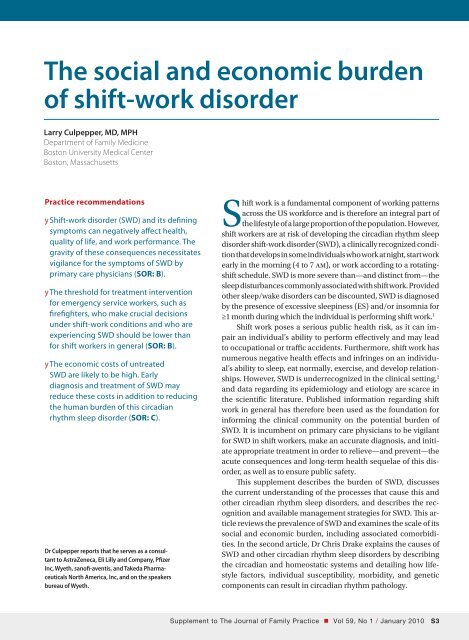Shift-work disorder - myCME.com
Shift-work disorder - myCME.com
Shift-work disorder - myCME.com
You also want an ePaper? Increase the reach of your titles
YUMPU automatically turns print PDFs into web optimized ePapers that Google loves.
The social and economic burden<br />
of shift-<strong>work</strong> <strong>disorder</strong><br />
Larry Culpepper, MD, MPH<br />
Department of Family Medicine<br />
Boston University Medical Center<br />
Boston, Massachusetts<br />
Practice re<strong>com</strong>mendations<br />
y <strong>Shift</strong>-<strong>work</strong> <strong>disorder</strong> (SWD) and its defining<br />
symptoms can negatively affect health,<br />
quality of life, and <strong>work</strong> performance. The<br />
gravity of these consequences necessitates<br />
vigilance for the symptoms of SWD by<br />
primary care physicians (SOR: B).<br />
y The threshold for treatment intervention<br />
for emergency service <strong>work</strong>ers, such as<br />
firefighters, who make crucial decisions<br />
under shift-<strong>work</strong> conditions and who are<br />
experiencing SWD should be lower than<br />
for shift <strong>work</strong>ers in general (SOR: B).<br />
y The economic costs of untreated<br />
SWD are likely to be high. Early<br />
diagnosis and treatment of SWD may<br />
reduce these costs in addition to reducing<br />
the human burden of this circadian<br />
rhythm sleep <strong>disorder</strong> (SOR: C).<br />
Dr Culpepper reports that he serves as a consultant<br />
to AstraZeneca, Eli Lilly and Company, Pfizer<br />
Inc, Wyeth, sanofi-aventis, and Takeda Pharmaceuticals<br />
North America, Inc, and on the speakers<br />
bureau of Wyeth.<br />
<strong>Shift</strong> <strong>work</strong> is a fundamental <strong>com</strong>ponent of <strong>work</strong>ing patterns<br />
across the US <strong>work</strong>force and is therefore an integral part of<br />
the lifestyle of a large proportion of the population. However,<br />
shift <strong>work</strong>ers are at risk of developing the circadian rhythm sleep<br />
<strong>disorder</strong> shift-<strong>work</strong> <strong>disorder</strong> (SWD), a clinically recognized condition<br />
that develops in some individuals who <strong>work</strong> at night, start <strong>work</strong><br />
early in the morning (4 to 7 am), or <strong>work</strong> according to a rotatingshift<br />
schedule. SWD is more severe than—and distinct from—the<br />
sleep disturbances <strong>com</strong>monly associated with shift <strong>work</strong>. Provided<br />
other sleep/wake <strong>disorder</strong>s can be discounted, SWD is diagnosed<br />
by the presence of excessive sleepiness (ES) and/or insomnia for<br />
≥1 month during which the individual is performing shift <strong>work</strong>. 1<br />
<strong>Shift</strong> <strong>work</strong> poses a serious public health risk, as it can impair<br />
an individual’s ability to perform effectively and may lead<br />
to occupational or traffic accidents. Furthermore, shift <strong>work</strong> has<br />
numerous negative health effects and infringes on an individual’s<br />
ability to sleep, eat normally, exercise, and develop relationships.<br />
However, SWD is underrecognized in the clinical setting, 2<br />
and data regarding its epidemiology and etiology are scarce in<br />
the scientific literature. Published information regarding shift<br />
<strong>work</strong> in general has therefore been used as the foundation for<br />
informing the clinical <strong>com</strong>munity on the potential burden of<br />
SWD. It is incumbent on primary care physicians to be vigilant<br />
for SWD in shift <strong>work</strong>ers, make an accurate diagnosis, and initiate<br />
appropriate treatment in order to relieve—and prevent—the<br />
acute consequences and long-term health sequelae of this <strong>disorder</strong>,<br />
as well as to ensure public safety.<br />
This supplement describes the burden of SWD, discusses<br />
the current understanding of the processes that cause this and<br />
other circadian rhythm sleep <strong>disorder</strong>s, and describes the recognition<br />
and available management strategies for SWD. This article<br />
reviews the prevalence of SWD and examines the scale of its<br />
social and economic burden, including associated <strong>com</strong>orbidities.<br />
In the second article, Dr Chris Drake explains the causes of<br />
SWD and other circadian rhythm sleep <strong>disorder</strong>s by describing<br />
the circadian and homeostatic systems and detailing how lifestyle<br />
factors, individual susceptibility, morbidity, and genetic<br />
<strong>com</strong>ponents can result in circadian rhythm pathology.<br />
Supplement to The Journal of Family Practice • Vol 59, No 1 / January 2010 S
















